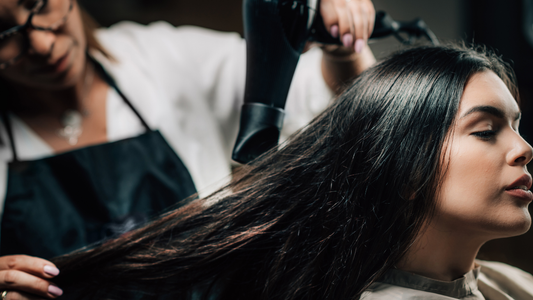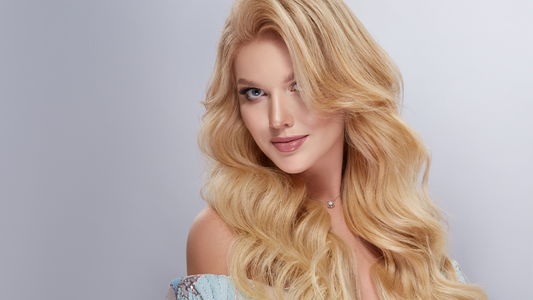Keratin treatments have become a popular solution for those seeking smooth, frizz-free, and manageable hair. Alongside keratin protein, many treatments, including some keratin formulas, contain silicones to enhance shine and create a sleek finish. Silicones are widely used in hair care products for their smoothing properties, but they can also lead to buildup and other issues if not properly managed.
In this article, we’ll explore the role of silicones in keratin treatments, discussing their benefits, potential downsides, and how to use them effectively for long-term hair health. We’ll also touch on how Kera Mane Keratin Hair Treatment balances the use of high-quality ingredients, offering smooth hair without the downsides of excessive silicone buildup.
What Are Silicones and How Do They Work in Hair Products?
Silicones are synthetic ingredients derived from silica, a natural compound found in sand. In hair care, silicones act as a smoothing agent, coating the hair shaft to provide a sleek, shiny appearance. They work by creating a protective barrier on the surface of the hair, locking in moisture and shielding it from environmental stressors like humidity, heat, and pollution.
There are different types of silicones used in hair care products, including water-soluble silicones (which rinse out easily with water) and non-water-soluble silicones (which tend to build up on the hair over time).
Common Silicones in Hair Products Include:
- Dimethicone: One of the most common non-water-soluble silicones, used for its excellent smoothing and anti-frizz properties.
- Cyclopentasiloxane: A lightweight silicone often found in leave-in treatments for its quick absorption.
- Amodimethicone: A water-soluble silicone that provides conditioning benefits without heavy buildup.
The Pros of Using Silicones in Keratin Treatments
Silicones are widely used in keratin treatments for good reason. They offer several benefits that can help enhance the smoothness and manageability of hair, particularly for those with frizzy or damaged hair.
1. Smooth and Silky Hair:
- Immediate Results: One of the primary benefits of silicones is their ability to make hair instantly feel smoother and silkier. The silicone coats the hair shaft, filling in rough spots on the cuticle and creating a polished, frizz-free appearance.
- Frizz Control: Silicones are particularly effective in controlling frizz, especially in humid conditions, by forming a barrier that prevents moisture from entering the hair shaft.
2. Shine Enhancement:
- Boosted Shine: Silicones are known for adding shine to hair by creating a reflective surface on the hair’s outer layer. This gives hair a glossy, healthy look after treatment.
3. Heat Protection:
- Shield Against Heat: When used in keratin treatments, silicones also provide a protective barrier against heat styling tools. This is particularly important during the application process, where heat is often used to lock in the keratin treatment.
4. Improved Detangling:
- Tangle-Free Hair: Silicones reduce friction between hair strands, making it easier to detangle hair and brush through knots without causing breakage.
5. Longevity of Treatment:
- Prolongs Smoothness: The barrier created by silicones helps prolong the effects of keratin treatments by sealing in the keratin proteins and locking out moisture that can cause frizz or revert hair to its natural texture.
The Cons of Using Silicones in Keratin Treatments
While silicones provide many benefits, there are some potential downsides that can arise, especially when certain types of silicones are used excessively.
1. Product Buildup:
- Non-Water-Soluble Silicones: Silicones like dimethicone are not water-soluble, meaning they can accumulate on the hair over time. This leads to a heavy, greasy feel and can weigh down the hair, making it look limp and lifeless.
- Barrier to Moisture: The coating of silicone can also block moisture from penetrating the hair shaft, leading to dryness over time. Hair may feel smooth on the surface but become dehydrated underneath the silicone layer.
2. Difficult to Remove:
- Requires Clarifying Shampoos: Non-water-soluble silicones are difficult to wash out with regular shampoos and often require the use of clarifying shampoos to remove buildup. Frequent use of clarifying shampoos, however, can strip the hair of natural oils and keratin, reducing the longevity of the treatment.
3. Temporary Effect:
- Superficial Benefits: While silicones can make hair appear healthier, the effects are often temporary and purely cosmetic. They don’t actually repair the hair, and once the silicones are removed, the underlying damage can become more apparent if the hair isn’t properly cared for.
4. Flat, Heavy Hair:
- Weighed-Down Locks: For those with fine or thin hair, silicones can weigh down the hair, leaving it looking flat and lacking volume. This can detract from the overall look of a keratin treatment, which is intended to provide smooth, but not heavy, hair.
How to Manage Silicone Buildup and Keep Hair Healthy
For those who want to enjoy the benefits of silicones without the downsides of buildup, here are some tips to keep hair smooth, healthy, and free from residue.
1. Use Products with Lightweight, Water-Soluble Silicones:
- Choose products that contain lighter silicones like amodimethicone, which rinses out more easily and doesn’t accumulate on the hair. These silicones provide smoothing benefits without the risk of buildup.
2. Clarify Hair Occasionally:
- To prevent buildup, use a sulfate-free clarifying shampoo once a month to remove any lingering silicones. This will refresh your hair without stripping it of essential moisture or keratin proteins.
3. Balance with Hydration:
- Make sure to incorporate moisturizing treatments such as masks or oils into your routine to balance out the potential drying effects of silicone use. Natural oils like argan and coconut oil can help nourish the hair from within, ensuring it stays hydrated.
4. Limit Overuse of Silicone-Based Products:
- Avoid layering too many silicone-heavy products, such as serums, conditioners, and styling sprays, as this can lead to faster buildup. Use silicone-based products sparingly and focus on high-quality, lightweight formulas.
How Kera Mane Balances Silicone Use for Best Results
At Kera Mane, we understand the importance of striking the right balance between achieving smooth, sleek hair and maintaining long-term hair health. Our Kera Mane Keratin Hair Treatment uses high-quality, lightweight silicones in combination with plant-based keratin and natural oils to deliver impressive results without causing buildup or damage.
Key Features of Kera Mane’s Formula:
- Water-Soluble Silicones: We use gentle, water-soluble silicones that offer the smoothing and frizz-control benefits of traditional silicones, but without the risk of heavy buildup. These silicones rinse out easily, ensuring that your hair remains light and voluminous.
- Nourishing Natural Oils: Our formula includes nourishing ingredients like argan oil, jojoba oil, and coconut oil, which help replenish and hydrate the hair. This ensures that while your hair is smoothed, it also receives the moisture it needs to stay healthy.
- Sulfate-Free Formula: By excluding sulfates, we reduce the risk of drying out the hair and allow the keratin treatment to last longer. This also helps maintain a proper balance of moisture and protein in the hair.
- Non-Greasy Finish: Kera Mane is designed to give you a sleek, smooth look without leaving hair feeling greasy or weighed down, ensuring you can enjoy the benefits of your treatment with confidence.
Conclusion
Silicones play a key role in the effectiveness of keratin treatments, offering immediate benefits such as smoothness, shine, and frizz control. However, their use must be balanced with careful product selection and maintenance to avoid the potential downsides of buildup and dryness. By opting for high-quality treatments like Kera Mane Keratin Hair Treatment, which uses lightweight, water-soluble silicones and nourishing oils, you can enjoy the best of both worlds: long-lasting smoothness and healthy, voluminous hair.
Understanding the role of silicones and their pros and cons can help you make informed choices about your hair care routine and ensure that your keratin treatment delivers optimal, long-term results.




